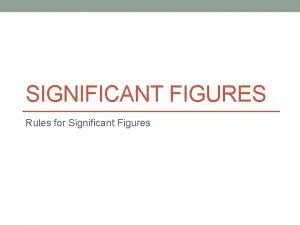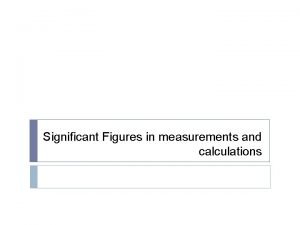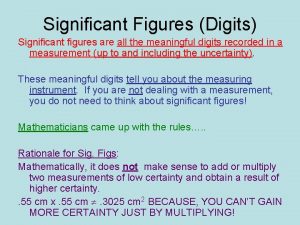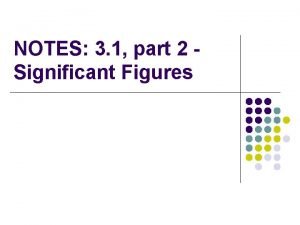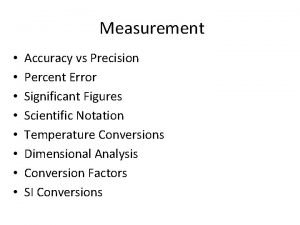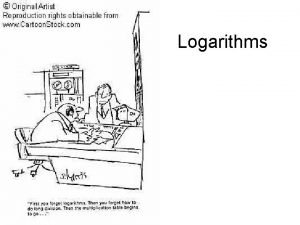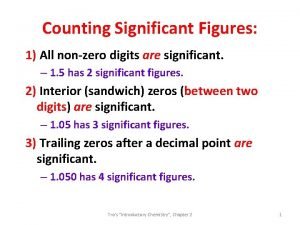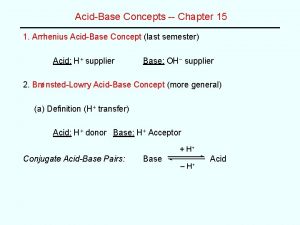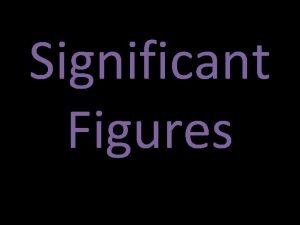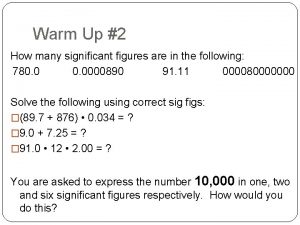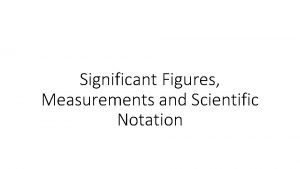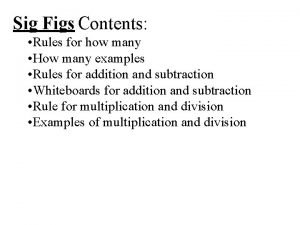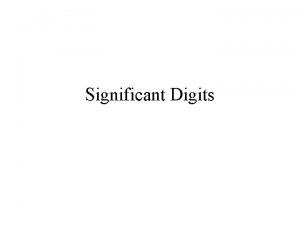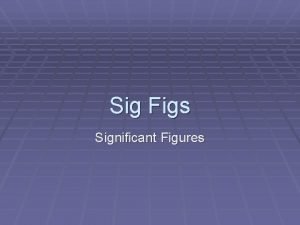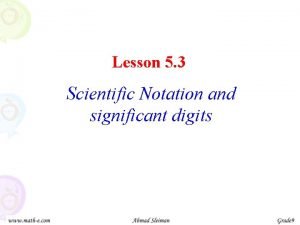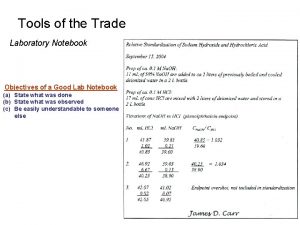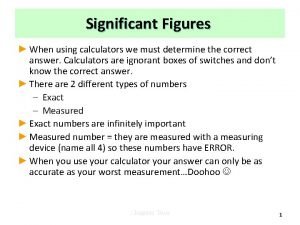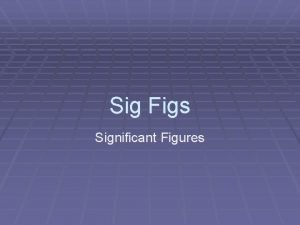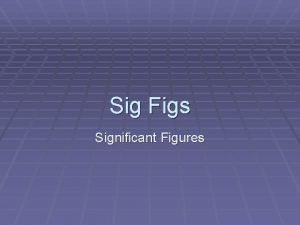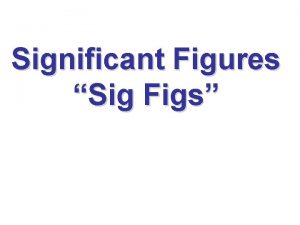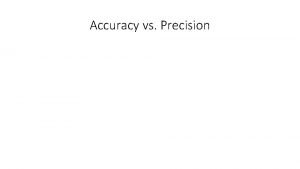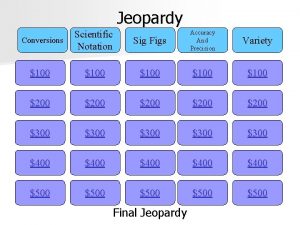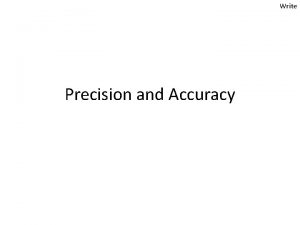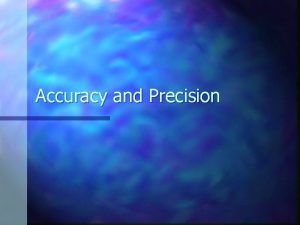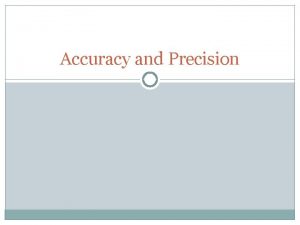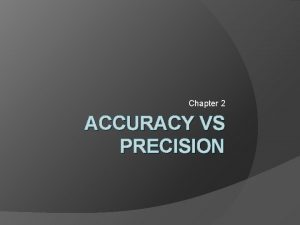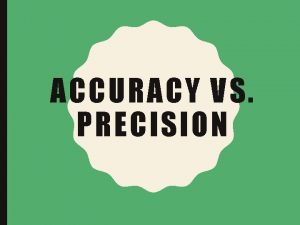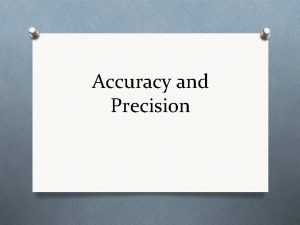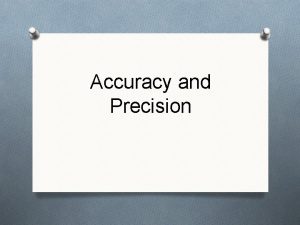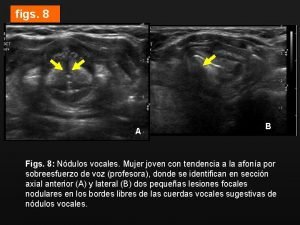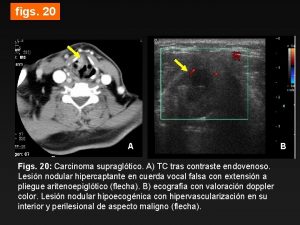Accuracy and precision and sig figs Accuracy and
































- Slides: 32

Accuracy and precision and sig figs

Accuracy and precision So much confusion over two words that are used almost interchangeably!!

Precision:

The agreement among several measurements that have been taken in the same way (Precision)

It says how reproducible the measurements are (precision)

Expressed in terms of deviation (precision)

q “tolerance” of an instrument is its degree of precision. For example, the usual platform balance has a tolerance of 0. 1 gram. (precision)

Accuracy: The closeness of a measurement to the accepted value

Here are some bull’s eyes that make it easy to remember accuracy/precision:

Precision? Accuracy?

Precision? Accuracy?

Precision? Accuracy?

Precision? Accuracy?

Sig Figs

Rules for sig figs (taken directly from page 26):

1. Non-zero digits are always significant

2. All final zeros after the decimal point are significant

3. Zeros between two other sig digits are always significant

4. Zeros used solely as placeholders are not significant

5. q The number of sig figs in a measurement is an indication of the precision with which the measurement was taken** **Take note: we make use of this fact in our lab measurements!! Remember to measure as far as there are divisions on the measuring instrument and then estimate one more.


10 20 30 40 50 1 2 3 4 5 What is the precision of these rulers?

Now let’s read measurements. 56. 0 units 10 30 50 70 90 11. 90 units 10 11 12 13 14 3. 75 units 1 2 3 4 5


Read the mass indicated below: 0 0 0. 1 100 10 20 30 40 50 1 2 3 4 5 0. 2 0. 3 0. 4 200 60 70 6 0. 5 7 0. 6 80 90 100 8 9 10 0. 7 0. 8 100 + 80 + 3 +. 470 = 183. 470 g 0. 9 1. 0 g

Arithmetic with sig figs:

Adding and subtracting q Perform the operation q Round off to the least precise value involved


Multiplying and dividing: q Perform the operation q Round off to the least number of sig figs in any factor



 Buret sig figs
Buret sig figs 3 significant figures example
3 significant figures example Sig figs rules
Sig figs rules How many sig figs on a thermometer
How many sig figs on a thermometer Significant figures chemistry
Significant figures chemistry Adding significant figures
Adding significant figures Math 55
Math 55 Sig figs with decimals
Sig figs with decimals Sig fig rules
Sig fig rules Oxidation reduction reactions
Oxidation reduction reactions 3 significant figures
3 significant figures Percent error sig figs
Percent error sig figs Log a x log a
Log a x log a What is a significant figure in chemistry
What is a significant figure in chemistry Hf acid or base
Hf acid or base Standard deviation sig figs
Standard deviation sig figs How do significant figures work
How do significant figures work Sig figs
Sig figs How many sig figs in 320
How many sig figs in 320 How many significant figures does 956 have
How many significant figures does 956 have How many sig figs in 5200
How many sig figs in 5200 How many sig figs in 7080
How many sig figs in 7080 Significant figures pacific atlantic
Significant figures pacific atlantic How many sig figs are in .000077?
How many sig figs are in .000077? Significant digits
Significant digits How many sig figs in 1250
How many sig figs in 1250 How many sig figs are in 5000
How many sig figs are in 5000 Where do sig figs come from
Where do sig figs come from How to count sig figs in scientific notation
How to count sig figs in scientific notation When to use sig figs in chemistry
When to use sig figs in chemistry Sug figs
Sug figs Logarithm significant figures
Logarithm significant figures Significant figures
Significant figures


